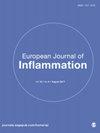Determination of high-sensitivity C-reactive protein reference intervals for apparently healthy children in Addis Ababa, Ethiopia
IF 0.8
4区 医学
Q4 IMMUNOLOGY
引用次数: 0
Abstract
Objective: Since then, the reference intervals of serum hsCRP in apparently healthy Ethiopian children are unknown. Therefore, this study aimed to determine the reference intervals of serum hsCRP for apparently healthy children. Methods: In this cross-sectional study, a total of 492 apparently healthy children aged 5–17 years were recruited from residents of Addis Ababa. Well-trained professionals took anthropometric measurements. The biochemical analysis was performed with the automatic biochemical analyzer Cobas Integra 400 Plus from Roche. The 2.5th and 97.5th percentile limits were calculated using a non-parametric method as per the Clinical Laboratory Standard Institute (CLSI) guide. A box plot was used to show the distribution of hsCRP by age and gender. Furthermore, bivariate and multivariable logistic regression analyses were carried out to evaluate factors associated with elevated hsCRP levels. Percentiles were displayed by age subgroup and sex. p-values <0.05 were considered statistically significant. Results: The study included 245 boys and 247 girls. For the age group of 5–11 years, the combined 2.5th and 97.5th percentiles, which can be used as a reference interval for children in Addis Ababa, were 0.15–6.78 mg/L, while for the older age group (12–17 years), the determined percentile was 0.14–4.40 mg/L. Likewise, the current study shows that never or occasionally eating vegetables and/or fruits (AOR = 2.28, 95% CI, 0.84–4.97), and being obese (AOR = 3.63, 95% CI, 1.14–11.53) were independent risk factors for elevated serum hsCRP concentrations. Conclusion: This study is the first to determine the reference intervals of hsCRP concentrations among apparently healthy Ethiopian children. Notable differences were observed in the established percentiles of hsCRP in comparison with published literature.埃塞俄比亚亚的斯亚贝巴表面健康儿童超敏C反应蛋白参考区间的测定
目的:从那时起,表面健康的埃塞俄比亚儿童血清hsCRP的参考区间尚不清楚。因此,本研究旨在确定明显健康儿童血清hsCRP的参考区间。方法:在这项横断面研究中,共从亚的斯亚贝巴的居民中招募了492名5-17岁的明显健康的儿童。训练有素的专业人员进行人体测量。用来自Roche的Cobas Integra 400Plus自动生化分析仪进行生化分析。根据临床实验室标准研究所(CLSI)指南,使用非参数方法计算第2.5和97.5百分位限值。使用方框图显示hsCRP按年龄和性别的分布。此外,还进行了双变量和多变量逻辑回归分析,以评估与hsCRP水平升高相关的因素。百分比按年龄分组和性别显示。p值<0.05被认为具有统计学意义。结果:该研究包括245名男孩和247名女孩。对于5-11岁的年龄组,可作为亚的斯亚贝巴儿童参考区间的第2.5个和第97.5个百分位数的总和为0.15-6.78 mg/L,而对于年龄较大的年龄组(12-17岁),确定的百分位数为0.14-4.40 mg/L。同样,当前的研究表明,从不或偶尔吃蔬菜和/或水果(AOR=2.28,95%CI,0.84-4.97),和肥胖(AOR=3.63,95%CI,1.14-11.53)是血清hsCRP浓度升高的独立危险因素。结论:本研究首次确定了明显健康的埃塞俄比亚儿童hsCRP浓度的参考区间。与已发表的文献相比,hsCRP的既定百分位数存在显著差异。
本文章由计算机程序翻译,如有差异,请以英文原文为准。
求助全文
约1分钟内获得全文
求助全文
来源期刊
CiteScore
0.90
自引率
0.00%
发文量
54
审稿时长
15 weeks
期刊介绍:
European Journal of Inflammation is a multidisciplinary, peer-reviewed, open access journal covering a wide range of topics in inflammation, including immunology, pathology, pharmacology and related general experimental and clinical research.

 求助内容:
求助内容: 应助结果提醒方式:
应助结果提醒方式:


